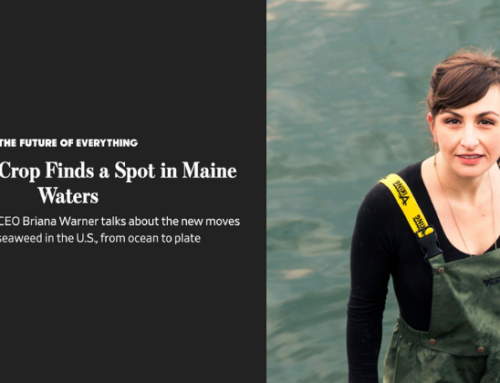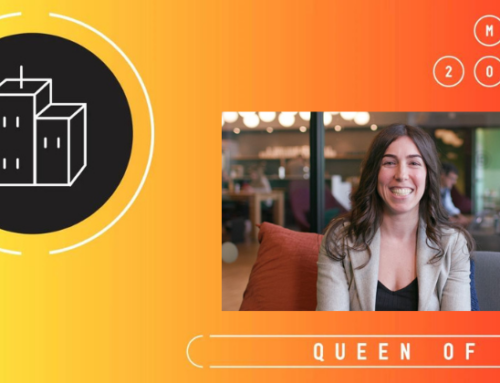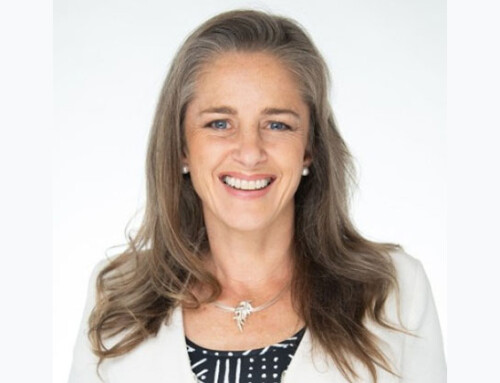Climate breakdown is causing the Gulf of Maine to heat up and that effect – in addition to the pandemic – is being felt across the lobster industry
Published on May 19, 2020
Gabriella Gershenson
Rocky shorelines and weathered saltbox homes dot the landscape of South Thomaston on the coast of Maine. Lobster traps take up frontyard real estate and lobster shacks, still shuttered for the season, are common sightings. Back from a day of scalloping, lobsterman Bob Baines has docked his boat, the FV Thrasher, at the Spruce Head Fishermans Co-op. His sternman, David McLellan, clad in waterproof overalls like Baines, shucks the last few hauls, tossing the meats into a bucket and the shells overboard.
It’s the last week of scallop season, but there is a new venture on the horizon. Baines, 64, steers the Thrasher back out toward Hewett Island on Penobscot Bay to check on the underwater kelp farm that he “planted” in December. It’s a willowy structure made up of moorings, buoys and ropes that hovers 7ft underwater and spans 1,000ft wide, like a monster cat’s cradle.
The only indicator that there is anything happening below the surface are the buoys that outline a hidden plot, with 13 parallel lines criss-crossing back and forth, each wrapped in a helix of twine impregnated with kelp seed that has grown into translucent brown ribbons.
Baines is among the latest of 19 veteran lobstermen along the Maine coast who are applying their hard-earned expertise to kelp farming. It’s boom time for lobster in Maine – 2019 was the fourth most profitable year in the history of an industry that accounts for $1bn in state revenue, second only to tourism. But a variety of factors, most of which can be traced to climate change, have left lobstermen more vulnerable than ever.
The lobster industry’s unprecedented growth may sound like a good thing, but the cause of it is alarming. According to a 2015 Science magazine study, the Gulf of Maine is heating up faster than 99% of the world’s oceans. This, in addition to proactive conservation efforts implemented over the years, has accounted for the flourishing of the lobster population; lobster are thriving in the slightly warmer waters. But lobstermen know better than to celebrate. All they need to do is look at what happened in the early 2000s in places like Connecticut, Rhode Island, and the Long Island Sound, where once-robust lobster fisheries have become commercially extinct due to the continually warming waters.
“I think we have a long time before that happens in Maine,” says Susie Arnold, a marine scientist at Maine’s Island Institute, who works with fishermen to diversify their businesses by including aquaculture, like kelp farming. “But the changes that are occurring are undeniable.”
Those changes aren’t good, but kelp farming has the potential for environmental good. “The ocean is a sponge for carbon dioxide,” says Nichole Price, senior research scientist and director of the Center for Seafood Solutions at the Bigelow Laboratory for Ocean Sciences in Maine. Carbon dioxide is the cause of ocean acidification, one of the myriad stressors responsible for destroying coral reefs and preventing mollusks from building their shells. Price has found evidence that sugar kelp has an especially high capacity for absorbing CO2 and thus lowering the acidity of the surrounding water. Investing in kelp farming now could potentially benefit marine life in the future.
The Maine coast is almost all lobster now, and it didn’t used to be that way,” says Baines, who has a close-cropped white beard, chiseled cheekbones and hazel eyes so deep-set that it often looks like he’s squinting. “When I was a teenager, in summertimes I worked in a lobster boat that went long-lining for ground fish – cod, haddock, hake – that were dominant in the Gulf of Maine.” The way Baines says “cod” sounds more like “caught”, as one might expect of a New Jersey native who spent his childhood summers in Maine and has lived his adult life here.
While Baines still goes out scalloping and sometimes fishes for halibut, most Maine lobstermen these days rely entirely on lobster to survive. If it’s a bad year for lobster, it’s a very bad year for lobstermen. And, in general, profit margins are lower than they were years ago, due to fuel costs and the rising price of bait and gear, in addition to regulations placed on lobster fishing by the federal government to protect the endangered right whale. Federal restrictions due to the trade war with China and the economic fallout caused by Covid-19 have further devastated their bottom line.
Kelp farming is positioned as a form of insurance, offering lobstermen such as Baines some of the financial security off-season fishing once did. He is one of the 24 “partner farmers” working with Atlantic Sea Farms, which was founded in 2009 under the name Ocean Approved as the first commercial seaweed farm and nursery in North America. (Baines’s daughter, Jesse, works for the company.) Atlantic cultivates seeds and gives them to partner farmers, assists with the design and layout of the kelp farms, and coaches farmers throughout the season – from setting up the farm in the winter to the harvest in spring, complementary to lobster’s summer to fall season. Because Atlantic Sea Farms seeks experienced lobstermen who already have equipment and know-how, start-up costs tend to be lower than those who are beginning from scratch.
The farmers grow two types of kelp – ripply sugar kelp and ribbon-like skinny kelp – which Atlantic then processes into a line of goods they sell online, to grocery stores, fast-casual chains, meal kit companies such as Daily Harvest, and national restaurants. Kelp grows 3-8lbs per foot of line, which means a farm with 13,000ft, the average size of Atlantic Sea Farms’ partner farmers’ lines, can potentially generate around $20,000 to $57,000 at harvest time.
In Southport, Maine, an hour down the coast from Baines’ kelp farm, husband and wife Alex Hutchins and Jodi Brewer are coming up on the end of their latest season growing kelp for Atlantic Sea Farms. This will be their third harvest – though last year an errant dock tore through their lines, sweeping their entire farm away. “We were getting ready to harvest,” says Hutchins, 35, wearing a weathered baseball cap, wisps of sandy brown hair poking out from underneath. “There were 18,000 feet of line, 3 ½ to 4lbs of kelp a foot, about 5 to 8ft long – we would have had 90,000lbs of kelp. We spent three days cleaning it up.”
After last year’s debacle, Hutchins babysits the plots regularly to see that the lines haven’t crossed, which would rub the kelp right off, and otherwise make sure that everything is looking right. If all goes well, he is projecting a 48,000lb harvest.
“I’m not much of a quitter,” says Hutchins. “When Jodi and I met, the price of lobster went down and I was washing windows for $10 an hour.” Hutchins, who comes from a long line of lobstermen, is no stranger to the turbulence of the trade. His family started fishing in Maine in the 1600s; he himself has been lobstering since he was eight, and started in earnest as a 20-year-old, with his father as his sternman. Until a few years ago, Hutchins fished for shrimp during the lobster off-season. He had invested in hundreds of shrimp traps right before the state closed the shrimp fishery in 2014, due to the warming waters. That is when he and Brewer turned to kelp.
“We wanted to fill the void where we had lost shrimping,” says Brewer, who wears a fleece pullover embroidered with her name, and punctuates her speech with nervous giggles. “The price of lobster is so volatile anyways,” adds Hutchins. “What we have going on right now with the coronavirus and the prices dropping. Normally this is the highest price time of year. I got $10.50 to $11 per lb this time last year. And now we’re at $4, $4.50. So it’s nice for me to have something else to fall back on besides lobstering.”
Back in South Thomaston, Baines cruises toward his kelp farm, pointing it out on a chart plotter, where it looks like a stick drawing of a rectangle on a digital screen. It appears straightforward enough, but creating a three-dimensional rope structure in the ocean is as challenging as you’d think.
“When you’re seeding the farm, you’re working out of a skiff, not out of a big lobster boat,” says Baines. “In a 14ft skiff in choppy waters, you’re bouncing all over the place. When I got home that first day of seeding, I hadn’t been that tired in I don’t know how many years of fishing.”
But the effort seems to be paying off. Baines lifts a line out of the water, from where kelp the color of a Budweiser bottle dangles like streamers and offers a sample. The flavor is fresh and vegetal, like underripe peas, and, surprisingly, not salty. No wonder it has gastronomic appeal. Atlantic Sea Farms’ kelp has been championed by the likes of Alice Waters, renowned chef, and made an appearance last March in a salad created by chef David Chang for the fast-casual chain Sweetgreen. At Chaval, a French and Spanish-influenced restaurant in Portland, kelp has found its way into the glass – dried and powdered, in a salted cocktail rim that tasted like the beach – and onto the plate – in an ethereally crisp churro stuffed with lemon cream, where kelp is integrated into the dough and blended into the sugar mixture that is sprinkled on top.
Despite the multifold promise of kelp, not everyone is on board with seaweed aquaculture. “Kelp farming is so new that for many fishermen, the initial reaction is ‘I don’t want that around here, that’s where I go lobstering’,” says Baines.
At a community hearing last year to review the lease for Baine’s kelp farm, other lobstermen complained that the aquaculture lease would somehow hamper their ability to catch lobster, even though kelp farming occurs from winter to the spring, during lobster’s off-season. “It’s not a reasonable argument,” says Baines. “Once they see that my lease didn’t bother anyone or take anything away from them, it will all settle right down.”
Meanwhile, Atlantic Sea Farms powers ahead. They have plans to move into a larger facility and there is a waitlist of fishermen who want to farm with them. They want to expand their network of partner farmers, which currently numbers 24. But due to the coronavirus outbreak, the waters have become choppy. In late March, Atlantic Sea Farms lost most of their food service clients, which made up about 50% of their accounts. Simultaneously, they saw increased retail and meal kit demand, and a surge in online sales. In the short term, they hope to shift the ratio of their contracts toward retail, with a Wegmans rollout and an expansion into Whole Foods in New England and other regions scheduled for the summer.
Bob Baines, Alex Hutchins and Jodi Brewer, and the rest of the partner farmers received an email in late March from Briana Warner, the chief executive of Atlantic Sea Farms, assuring them that the company is still committed to buying their kelp. “Lobster prices dropped dramatically and we are heading into the lobster season very soon, so this kelp income matters more than before,” says Warner. “It could be a very hard season.” To meet the CDC standards for social distancing, Atlantic Sea Farms will not be bringing in their usual seasonal workers who commute from Massachusetts each day during harvest to process the kelp. Instead, it will be done with a local skeleton crew made up mostly of the company’s management team. “It hurts but we’ll get through it,” says Warner.
As for the farmers, they are happy to have work they can rely on. “This is the hardest time of year for commercial fishermen,” says Hutchins of the winter-spring season. “And this year, not knowing what will happen with the lobster market as a whole, it’s nice to know I have something coming in.”
We’ve never had a better chance …
… to make a greener world. Covid-19 has delivered unusual environmental benefits: cleaner air, lower carbon emissions, a respite for wildlife. Now the big question is whether we can capitalise on this moment. The Guardian aims to lead the debate from the front.
In the weeks and months ahead, our journalism will investigate the prospects for a new green settlement. We will showcase the big thinkers and protagonists and amplify the arguments for authorities everywhere to consider as they lead us out of coronavirus.
Our credentials suit us well to the task: we are independent, we have no owners, no paymasters or oligarchs pulling the strings. We have committed to carbon neutrality, divested from the oil and gas sectors and renounced fossil fuel advertising. But at this crucial moment, news organisations like ours are facing a daunting financial challenge. As businesses everywhere feel the pinch, the advertising revenue that has long helped to sustain our work has plummeted. We need you to help fill the gap.
Our journalism is open to all because we believe everyone deserves access to factual information, regardless of where they live or what they can afford to pay. If you can afford to, we hope you will consider supporting our journalism today.
The Guardian believes that the climate crisis we face is systemic. We will inform our readers about threats to the environment based on scientific facts, not driven by commercial or political interests. We will keep reporting on the efforts of individuals and communities around the world who are fearlessly taking a stand for future generations and the preservation of human life on earth. We want their stories to inspire hope.
We need your support to keep delivering this kind of open, committed independent journalism. Every reader contribution, however big or small, is so valuable.
Link to Read More: https://www.theguardian.com/environment/2020/may/19/im-not-a-quitter-lobstermen-turn-to-kelp-farming-in-the-face-of-global-crises






